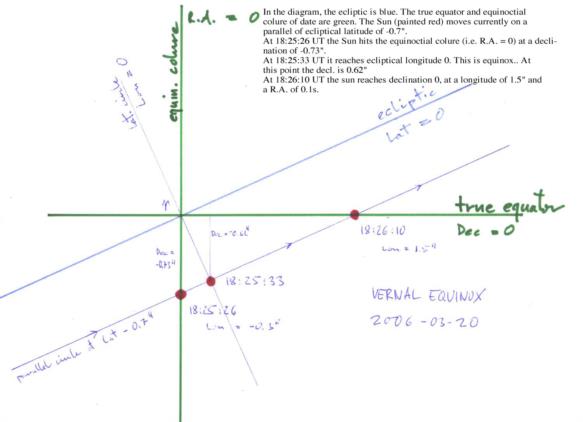
NavList:
A Community Devoted to the Preservation and Practice of Celestial Navigation and Other Methods of Traditional Wayfinding
Re: Vernal equinox
From: Peter Hakel
Date: 2014 Mar 21, 20:29 -0700
From: Peter Hakel
Date: 2014 Mar 21, 20:29 -0700
Thanks for the clarification. To answer your question: I identified equinox with Dec = 0; which then also coincided with RA = 0 within the precision of this calculation (and within 1 second of UT). While the spreadsheets are adequate for celestial navigation, I refrain from claiming accuracy of the order of 1”.
Peter Hakel
From: Bill B <billyrem42@earthlink.net>
To: pmh099@yahoo.com
Sent: Friday, March 21, 2014 6:31 PM
Subject: [NavList] Re: Vernal equinox
Peter Hakel
From: Bill B <billyrem42@earthlink.net>
To: pmh099@yahoo.com
Sent: Friday, March 21, 2014 6:31 PM
Subject: [NavList] Re: Vernal equinox
On 3/21/2014 6:06 PM, Peter Hakel wrote: > Declination is measured against the celestial equator - are you > referring to precession and nutation? Can you point me to H. Prinz's > original postings? I can do better than point you. Below is the text. The text is also attached as a ms word.doc, and the diagram as a jpeg. Dug them up this AM from and old machine. Honestly, there was a term I had to Google at the time in an attempt to grasp Herbert's scholarly explanation. All said and done, it fell into my "things I didn't know I didn't know" sphere of ignorance. :-) ========================================================== https://navlist.net/m2.aspx/Welcome-Spring-or-Fall-HerbertPrinz-mar-2006-w27802 Oops! You are some 5 minutes early. The correct value is 18:25:33. If you compute this from the N.A. you should be able to get the time within an accuracy of better than 15 seconds. I don't have a N.A. handy to check it out. In sync with the equinox related traffic that occurs with a period of 0.5 tropical years on this list, I posted a diagram showing the apparent place of the sun around today's equinox with respect to the two fundamental reference frames: http://www.hprinz.us/equinox.jpg In the diagram, the ecliptic is blue. The true equator and equinoctial colure of date are green. The Sun (painted red) moves currently on a parallel of ecliptical latitude of -0.7". At 18:25:26 UT the Sun hits the equinoctial colure (i.e. R.A. = 0) at a declination of -0.73". At 18:25:33 UT it reaches ecliptical longitude 0. This is equinox.. At this point the decl. is 0.62" At 18:26:10 UT the sun reaches declination 0, at a longitude of 1.5" and a R.A. of 0.1s. All data computed with MICA Vers. 2, U.S.N.O. Conceptually, equinox implies that the declination of the sun equals zero. Hipparchus supposed this to happen in the equinoctial point, i.e. at zero longitude. When it was realized after Newton that the apparent Sun does not necessarily have to move through the equinoctial point each year, one had to make a decision whether to choose zero longitude or zero declination for the definition of equinox. Longitude was more practical. How come the Sun has latitude? Hint: The latitude of the Sun is always very roughly (give or take 0.2") that of the Moon, divided by 32000. Have fun. Herbert Prinz
Attached File:

(img/127334.equinox diagram.jpg: Open and save)
Attached File:

(img/127334.equinox.doc: Open and save or View online)

(img/127334.equinox diagram.jpg: Open and save)
Attached File:

(img/127334.equinox.doc: Open and save or View online)
: https://navlist.net/m2.aspx?i=127334






